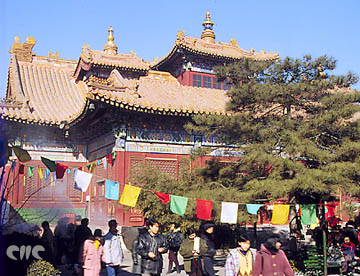| Tools: Save | Print | E-mail | Most Read |
| A Place for Visitors and Worshippers |
| Adjust font size: |
Watching different people pay their respects to Buddha by burning incense and praying is one of the most striking sights when visiting the Yonghegong Lamasery, known simply as the Most people get down on their knees on a cushion and present joss sticks, or burning incense, to the Buddha statutes.
Buddhist worship involves bowing to express gratitude to Buddha for his teachings. The burning incense is a reminder of the influence of virtue. Those who come to worship light incense around braziers and wave them in between their palms as they pray to the Buddha within themselves. Buddhists do not pray directly to the statutes, as they are only symbols of the features of Buddha. The way they pay homage is to clasp their palms, kneel and say a devotional recitation.
The temple was originally built in 1694 as the residence of the son of the Qing Emperor, Kangxi. When the prince, Youngzheng, became emperor in 1723 he moved to the Today it is still a monastery for Mongolian and Buddhist Monks. It remains one of the most impressive Buddhist temples in Inside, there are many different temples and within each temple there are different statues of Buddha. There are also courtyards, alleyways and benches for visitors to wander.
Among the many temples, the ones with the yellow-tiled roofs were originally where the emperors lived in as yellow was the royal color in Imperial China. The entrance fee to the temple is 25 RMB and there are English audio tours available. Even if you do not practice Buddhism but would like to particpate, you can buy incense and souvenirs at the dozens of stores along the road beside the temple. The No.13 Travel tips:
Add: Andingmen Dongdajie, Dongcheng District. 010- 6404 9027. Ticket: 25 yuan. Opening hours: 09:00 - 17:00 How to get there: Bus routes: 13, 62, 44, 406 at Yonghegong station; or take the subway to arrive at Yonghegong. (
|
| Tools: Save | Print | E-mail | Most Read |
 |
| Related Stories |
|
|
Product Directory China Search |
Country Search Hot Buys |



